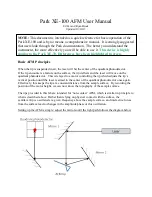
LSM 710 and LSM 780
LEFT TOOL AREA AND HARDWARE CONTROL TOOLS
Systems
Processing Tab
Carl Zeiss
02/2010 M60-1-0025
e
121
The following additional settings and functions are available for linear unmixing (see Fig. 127):
Auto scale
balances the intensity of the unmixed channels to equal levels.
Display Channel with Residuals
generates an
additional channel in which the intensity values
represent the difference between the acquired
spectral data and the fitted linear combination of
the reference spectra. In essence, the residual value
is the biggest remaining "residual" from the least
square fit routine. The residuals are a general
measure for how good the fit of the algorithm has
performed. The higher the intensity in this
additional channel, the worse is the fit of the
spectra to the dataset. This shows that either the
acquired data is not representing the sample (e.g.,
when information is lost by pixel saturation) or
wrong/insufficient reference spectra have been
chosen. In this case, new image acquisition with no
overexposed/ saturated pixels is strongly
recommended. In the case of wrong reference
spectra, choosing/acquisition of different/new
reference spectra can be necessary to improve the
results.
Background:
Select a background spectrum from
the list of selected components. This spectrum is
then subtracted from the images prior to
unmixing. For example: three components selected
and one of them marked as background will
substract the selected background from the
acquired images and generate a 2-channel
unmixed image. For the generation of background
spectra refer to the Unmixing View type/Lambda
stack – specific view (see section
Unmixing View
).
Even small background contributions to the image
should be indicated to the unmixing algorithm to
ensure best unmixing results.
Weighted
unmixing:
When this option is
checked, spectral channels with high noise do
contribute less to the unmixing result. This option
includes a statistical analysis of the signal-related
(Poisson-) noise and weighs the respective
contribution to the fitting of the combination of
reference spectra to the experimental data. Note:
this option involves a more sophisticated unmixing
algorithm and therefore takes longer than the
basic unmixing analysis. Weighted unmixing
generates improved unmixing results when
acquisition channels are not so well balanced but
still have a good signal-to-noise ratio.
Fig. 128
Linear Unmixing: Spectra and LUT
assignment















































